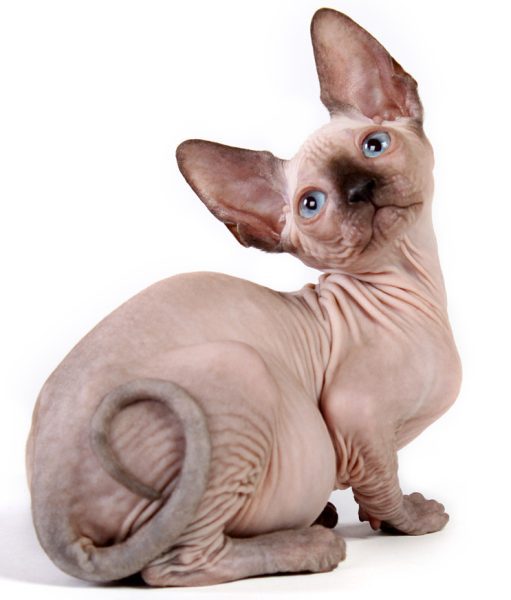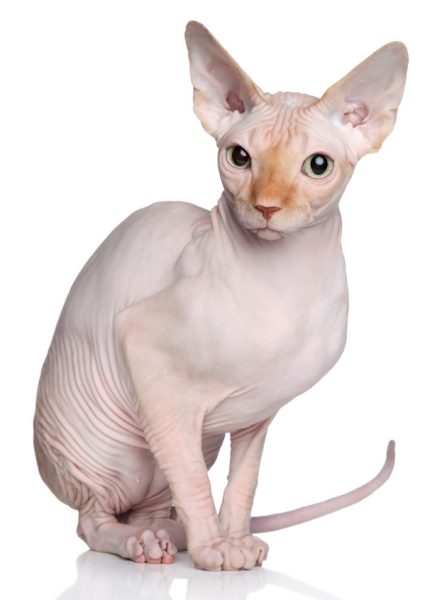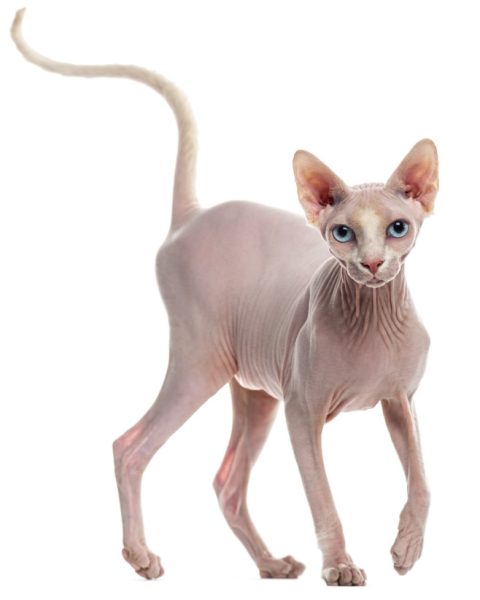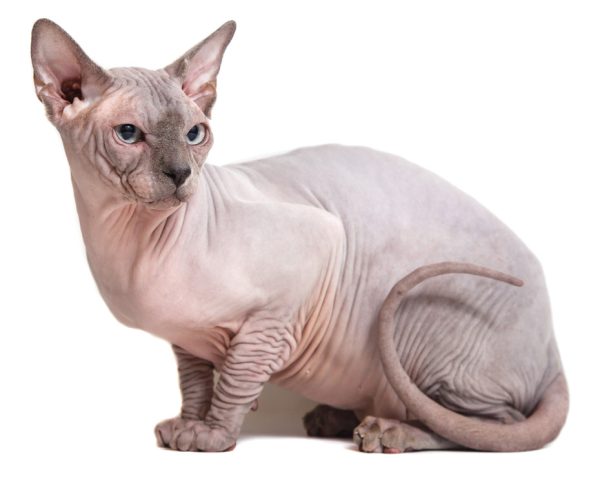Sphynx Cat

Sphynx Cat Personality
The affectionate Sphynx cat loves to get close to its owners. This is partly because this hairless cat wants to keep warm. However, the Sphynx is also a very friendly cat that likes to be touched and petted. These felines tend to get along well with other cats and dogs.
Highly sociable, the Sphynx is fond of company. Having two cats will ensure that when left alone, there is always company. Often, when two Sphynx cats live together, they will move around as a pair. This is especially true if they are investigating something new.
Eager to help their owners with whatever they are doing, a Sphynx will also greet house guests with a gentle butt of the head. Flirtatious, fearless, and mischievous, these smart felines will always entertain their owners with their fun behaviors.

Appearance
The most distinctive feature of Sphynx cats is their lack of hair. Although some are completely hairless, many are covered with a soft downy fuzz (much like the outside of a peach). Despite this, they are warm and soft to the touch. However, short fine hair may be found on the feet, edges of the ears, and the tail. These felines are medium-sized and sturdy with broad, rounded chests and round abdomens. Their wedge-shaped head is wrinkled with very large, wide ears that sit upright—giving them an almost alien-like appearance.
Size
- Weight: These felines weigh between 6 and 14 pounds, with males weighing more
- Height: Sphynx cats can be between 8 and 10 inches tall
- Length: Typically between 13 and 15 inches
Dwarf Sphynx Cats
Sometimes referred to as a Dwarf Sphynx, the Munchkin Sphynx cat is a short-legged mixed breed that has become popular in recent years. Because of their stature, this is not a cat that will be able to jump any considerable height. They also tire easily. Like Sphynx cats, these felines are loving and affectionate. Due to its lack of mobility, this is a cat that is best kept indoors.

Sphynx Cat Colors
The Sphynx can be found in a wide variety of colors, including black, white, red, silver, cream, gold, tortoiseshell, blue-cream, brown, and cameo.
Common patterns include:
- Tortoiseshell
- Tricolor
- Bicolor
- Calico
- Tabby
- Smoke
- Ticked
- Shaded
Even though the Sphynx is hairless, it is not hypoallergenic. In many cases, people can be more allergic to hairless cats than those with fur. This is because most people with cat allergies are allergic to dander or saliva—not fur. The Sphynx is one of the most popular cat breeds.

History of the Sphynx Cat
The much-loved and distinctly hairless Sphynx cat is a relatively new breed. This contemporary variation came about through selective breeding back in the 1960s and 1970s and is notably different from other hairless cats such as Donskoy and Peterbald.
Although hairless cats have been common throughout history, the Sphynx can be traced directly back to two sets of cats in North America. All of these down-covered felines can either follow their lineage back to barn cats Dermis and Epidermis from Minnesota or to strays Bambi, Punkie, and Paloma in Toronto.
The Canadian Sphynx cat breed came about when a hairless cat was born to a domestic shorthair. The kitten was then backcrossed with his mother, producing another “naked” kitten. Originally referred to as the Canadian Hairless, these felines were later renamed Sphynx. The two Minnesota Sphynxes were discovered around the mid-1970s and were naturally occurring examples of the breed.
Issues surrounding the size of the gene pool and fertility meant that the breed was not formally recognized for championship status by the Cat Fancier’s Association until 2002. It was not until a breeder discovered three kittens on the street and bred two of them with a Devon Rex from Europe that the breed was refined.

Caring for the Sphynx Cat
Grooming
Due to the hairless nature of the Sphynx, it would be assumed that grooming would not be essential. This is not the case. This feline’s body can become oily, and it must be bathed a least once a week to ensure its pores are not clogged. As with most cats, a Sphynx is not guaranteed to enjoy being bathed. However, if plenty of attention is given, it is possible to distract them until the task is complete.
The Sphynx will also require its nails to be trimmed often, as well as any mucus cleaned from the eyes and ears. In addition to this, dental care is also important. Brushing the cat’s teeth with a special pet toothbrush will help prevent any dental issues.
Exercise
Sphynx cats are usually active, but their overall exercise needs are low. However, their intelligence and curiosity mean they will enjoy interactive cat toys and puzzles. They love to jump so a cat tree would be a good investment.
Health Conditions
A Sphynx does not fare well in the cold or direct sunlight, many owners invest in sweaters for these felines during the colder months. In addition, due to their hairlessness, Sphynx cats are sensitive to sun exposure because there is no fur to protect the skin from harmful UV rays. Just like humans, a Sphynx can get sunburned. These cats do best living indoors. If they go outside, they should be monitored closely.
The typical Sphynx cat lifespan is between 8 and 14 years. As with any feline, the Sphynx has the potential to develop health issues. However, providing regular check-ups with a veterinarian and inoculating the cat with core vaccines (such as those for rabies, distemper, and FIV) will help them stay healthy. In addition, owners should give preventive medications, such as those for heartworm and fleas.

Although the breed is generally healthy, it is important to know about any conditions that apply to this type of cat, including those listed below.
- Hereditary myopathy is a condition that affects the function of the muscles. When it develops to the stage where a cat can no longer swallow, it will cause death. Fortunately, this is a rare condition that breeders are working on eradicating.
- Hypertrophic cardiomyopathy is one of the most common types of heart disease in cats and is known to affect this breed. It occurs when the heart muscle thickens. A vet will carry out an echocardiogram to confirm whether the condition is present in a cat.
- Skin conditions called urticaria pigmentosa and cutaneous mastocytosis can affect these felines.
- Periodontal disease or gum disorders are common in Sphynx cats. These problems can be prevented with regular brushing of the teeth.
One of the best ways to ensure a Sphynx remains healthy is to ensure a good diet and plenty of opportunities for exercise. Many health issues can be exacerbated when a cat is overweight. Although the Sphynx has a pronounced belly, it should never be allowed to get overweight.
When adopting or buying a Sphynx cat, it is worthwhile investing in pet insurance to ensure any health concerns can be managed without having to worry about excessive vet bills.
Sphynx Cat Adoption
When deciding whether to buy or adopt a Sphynx cat, it is important to understand that there are often plenty of healthy animals of every breed in local rescues and shelters. No-kill shelters are recommended as they will have policies to ensure they never euthanize a healthy cat. Not only will adopting a pet in this way mean that it will go to a good home, but it is also cheaper than buying from a breeder or pet store. To find Sphynx cats for rehoming, search for specialist rescue centers for the breed.



